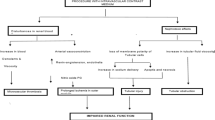Abstract
Purpose: We performed a basic investigation using white rabbits of the sustained release and embolizing effects of poly L-lactic acid microspheres (PLA) to determine their usefulness for chemoembolization.
Methods: Fifteen male Japanese white rabbits were used. Sustained release of an embolizing material, EPI-PLA was accomplished with l m g of PLA containing 0.03 mg of epirubicin hydrochloride (EPI). Embolization with 50 mg of PLA (total dose of EPI l.5 mg) was performed after the renal artery of the rabbits was selected (Chemo-TAE group). A group in which a bolus of 1.5 mg EPI alone was injected through the renal artery (TAI group) was established as a control group. Furthermore, a group in which embolization was performed with 50 mg of PLA alone (TAE group) was also established. These three groups, each consisting of five rabbits, were compared.
Results: Blood EPI levels were serially measured. The blood EPI level in the TAI group rapidly reached a peak more than 30 min after injection, then decreased to almost zero 24 hr after injection. In the Chemo-TAE group, the blood EPI level was transiently increased 30 min after embolization, but remained low thereafter until 24 hr after embolization. EPI levels in kidney tissue isolated 24 hr after embolization were measured. In the Chemo-TAE group, the tissue EPI level was significantly higher than that in the TAI group. When isolated kidneys were macroscopically and histologically examined, atrophy of the entire embolized kidney, as well as infarction and necrosis in the renal cortex, were observed in both the TAE group and the Chemo-TAE group. However, there were no such findings in the TAI group. The area of the infarction in the renal cortex did not significantly differ between the Chemo-TAE group and the TAE group; however, there was vascular injury in the Chemo-TAE group and none in the TAE group.
Conclusion: It was demonstrated that EPI-PLA, a chemo-embolizing material, maintained high local concentrations of the anticancer drug, while maintaining low blood levels of the anticancer drug.
Similar content being viewed by others
References
Ike O, Hitomi S, Shimizu Y, Wada R, Watanabe S, Hyon SH, Ikada Y (1990) Administration of the adriamycin-containing poly (L-laetic acid) microspheres into the pleural cavity of patients with malignant pleural effusion. Drug Delivery System 1:23–27
Ike O, Watanabe S, Nakamura T, Wada R, Hyon SH, Hitomi Y, Ikada Y, Shimizu Y (1988) Release and degradation characteristics and antitumor effect of adriamycin containing poly L-Iactie acid microspheres. Adv Biomaterials 8:257–262
Itoi K, Tabata C, Ike O, Shimizu Y, Kuwabara M, Kyo M, Hyon SH, Ikada Y (1996) In vivo suppressive effects of copoly(glycolic/L-lactic acid) microspheres containing CDDP on murine tumor cells. J Control Release 42:175–184
Fujiwara K, Hayakavva K, Nagata Y, Hiraoka M, Nakamura T, Shimizu Y, Ikada Y (2000) Experimental studies of transcatheter renal arterial embolization using poly L-lactic acid microspheres. Jpn J Cardiovasc Intervent Radiol (in submission)
Murata K (1995) Biogradable microcapsules containing an anticancer drug: Experimental studies of drug release and toxicity. J Jpn Cancer Ther 30:883–896
Fujiwara K, Okuno Y, Hayakawa K, Nakamura T, Shimizu Y, Takebayashi Y, Tabata Y, Ikada Y (1992) Experimental studies of trans-catheter hepatic arterial embolization using poly L-lactic acid microspheres. Jpn J Artif Organs 21:1071–1075
Nakamura H, Hashimoto T, Taguchi T, Oi H, Inoue K, Seki K, Mizumoto S, Tsukaguchi I, Araki Y, Sawada S (1987) Oily chemoem-bolization of hepatoma. Jpn J Cancer Chemother 14:381–387
Nakamura H, Hashimoto T, Taguchi T, Inoue K, Oi H (1986) Transcatheter oily chemoembolization of hepatocellular carcinoma using adriamycin, lipiodol and gelfoam. Jpn J Cancer Chemother 13:623–625
Juni K, Ogata J, Nakano M, Ichihara T, Mori K, Akagi M (1985) Preparation and evaluation in vitro and in vivo of polylactic acid microspheres containing doxorubicin. Chem Pharm Bull 33:313–318
Doppman JL, Girton M, Kahn R (1978) Proximal versus peripheral hepatic artery embolization experimental study in monkevs. Radiology 128:577–588
Stridbeck H, Lorelius LE (1985) Liver necrosis after hepatic dearterialization in pigs. Cardiovasc Intervent Radiol 8:50–53
Ike O, Wada R, Kusanoi Y, Watanabe S, Hyon SE, Ikada Y, Shimizu Y (1990) Cis-diamminedichloroplalinum delivery system using poly-(lactic acid). Drug Delivery System 1:29–32
Kumanohoso T, Natsugoe S, Shimada M, Sagara T, Aikou T, Shimazu H, Shinkawa T, Nakamura K, Fukuzaki H (1993) A basic study on usefulness of bleomycin incorporated in Poly DL-lactic acid. Jpn J Cancer Chemother 20:1572–1574
Author information
Authors and Affiliations
Rights and permissions
About this article
Cite this article
Fujiwara, K., Hayakawa, K., Nagata, Y. et al. Experimental embolization of rabbit renal arteries to compare the effects of poly L-lactic acid microspheres with and without epirubicin release against ntraarterial injection of epirubicin. Cardiovasc Intervent Radiol 23, 218–223 (2000). https://doi.org/10.1007/s002700010046
Issue Date:
DOI: https://doi.org/10.1007/s002700010046




